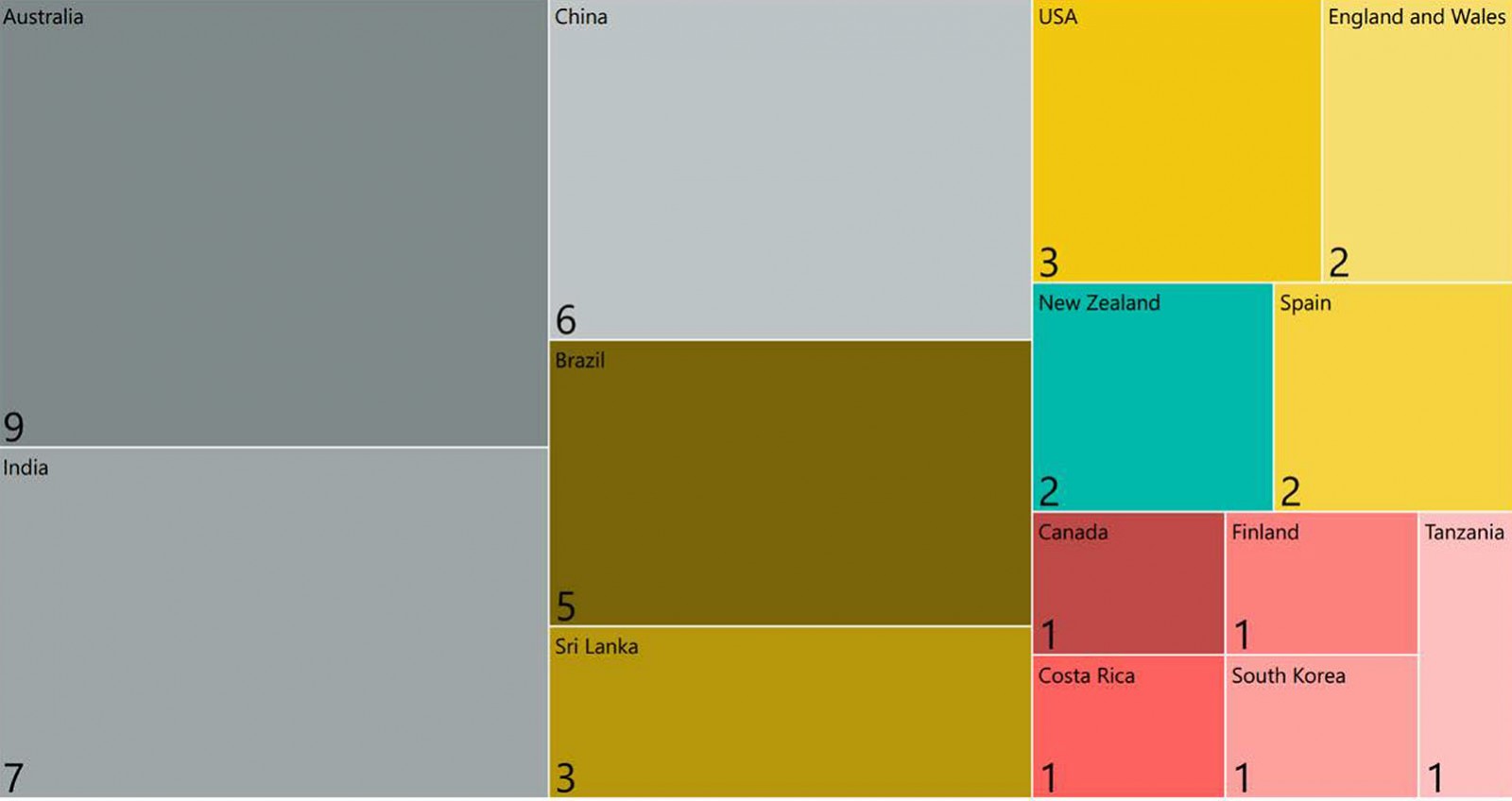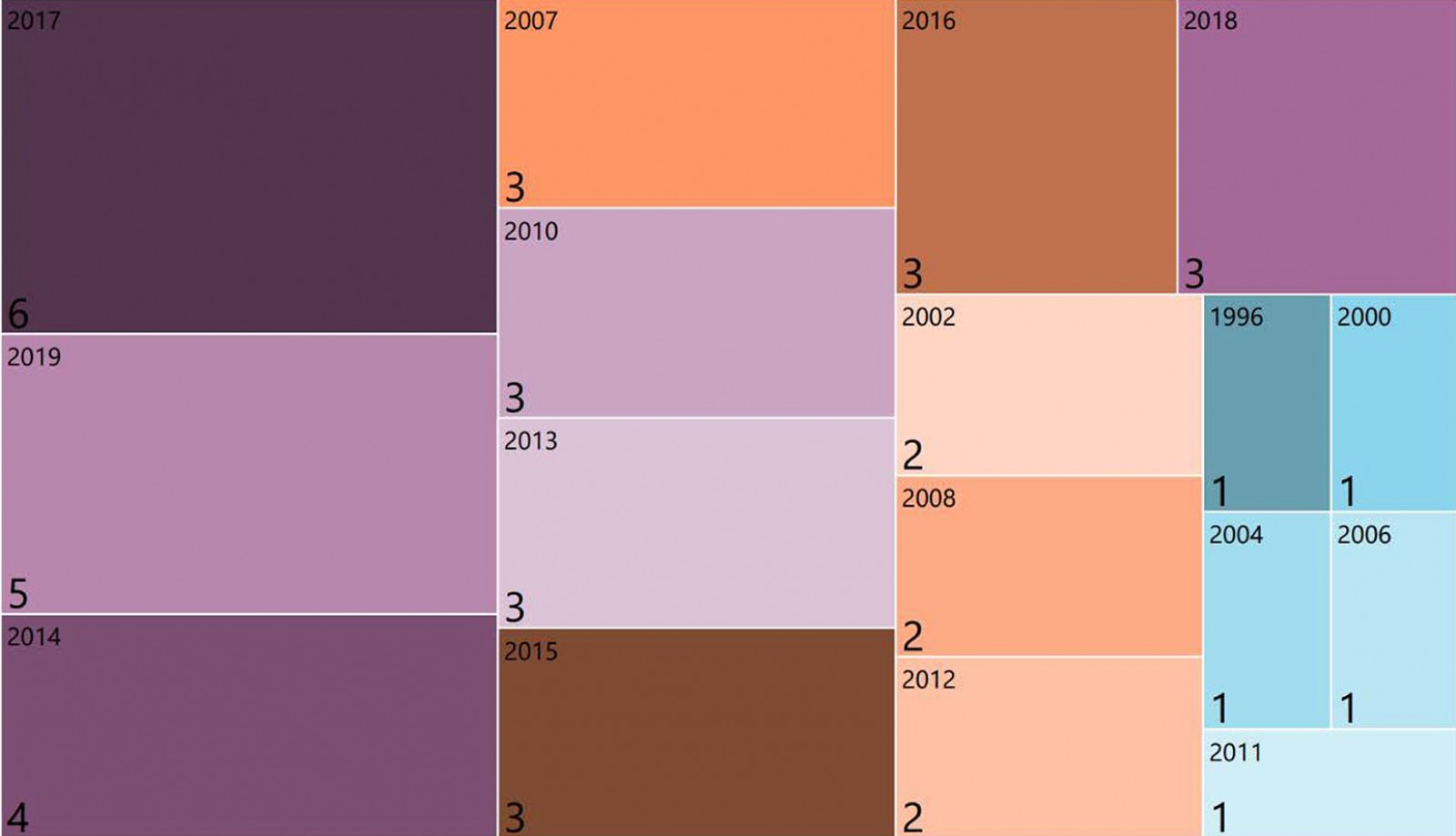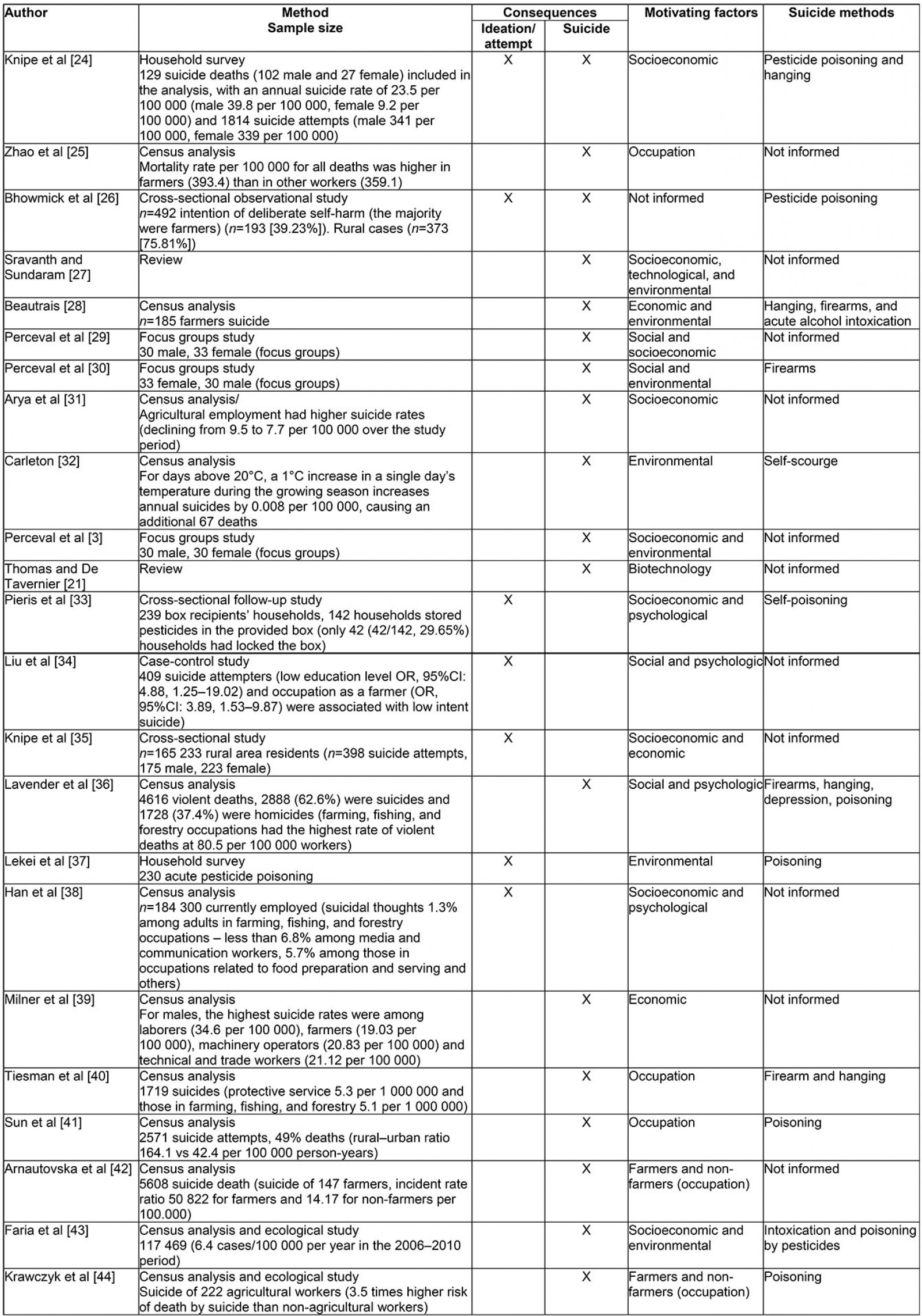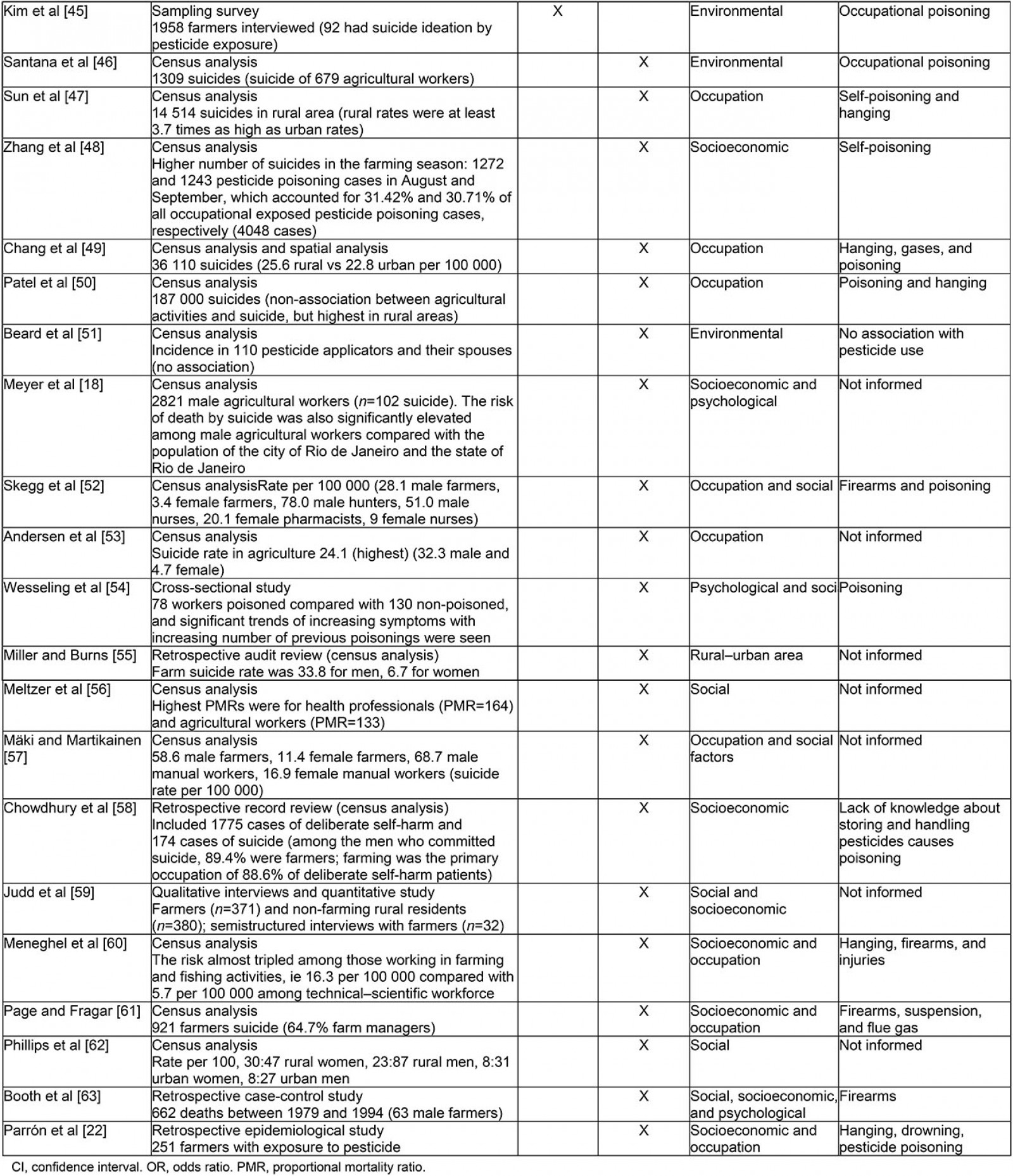Introduction
Suicide is a concerning and significant cause of death every year worldwide1. Suicide-prone people are mainly those in vulnerable situations, people with drug and alcohol dependencies, victims of violence, refugees, immigrants, and those who find themselves in stressful working situations2,3. The existing literature points to different suicide approaches, which may be ideation, attempt, or suicide itself4. Workers may be exposed to health risk factors in their work environment, compromising their quality of life and performance, highlighting the relevance of studies on the collective health of this profession5.
According to the World Health Organization, there are more than 800 000 suicide victims every year. Thus, every 40 seconds, a person takes their life; 20% of those deaths are from pesticide poisoning, and 80% occur in low- and middle-income societies, especially in rural and agricultural areas1,3.
Agricultural work is one of the hardest activities in any country6, being one of the most dangerous regarding occupational hazards and injuries7,8, and causes occupational deaths among related professions such as business and IT9. The occupational class of agricultural workers and farmers has been highlighted as the most likely to commit suicide3.
Among the factors that affect agricultural workers and demotivate them, causing them to leave rural areas, are low pay, lack of recognition10-12, and the physical effort required by their activities13. Research on agricultural workers has addressed stress and depression14-16, pesticide contamination17-19, and respiratory problems20. However, previous reviews have focused only on agricultural workers in certain countries (eg India), or on a few aspects, such as technology that replaces humans with machines21.
Therefore, the question that stimulated the development of this research was: what are the motivating factors of death by suicide and methods for attempted suicide among workers who perform rural activities?
Thus, the objective of this research was fourfold: (i) analyze which countries have the largest number of publications on suicide among agricultural workers, (ii) understand the factors that lead to either suicide or intent, (iii) identify the methods of suicide or attempted suicide, and (iv) propose preventive measures so that agricultural workers are not exposed to risk factors for suicide. Thus, the main suicide methods, the motivating factors, the countries with the most occurrences and cases of death or suicidal ideation identified in the existing literature are presented, and preventive measures are outlined to mitigate the number of deaths and promote the health of agricultural workers.
Methods
Strategy for search and selection of relevant literature
The keywords defined for the searches were ‘suicid*’ and variations for agricultural workers, such as ‘rural work*’, ‘agricultural work*’, ‘farm work*’, and ‘farm*’. The databases used were Scopus, MEDLINE via PubMed, Lilacs, and Science Direct. There was the combination of the word ‘suicide’ with the variations for agricultural workers.
An initial date for searching the articles was not delimited because the authors aimed for a broader coverage on the theme. However, the first relevant study was published in 199622. The final date for the searches was June 2019.
Article eligibility criteria and review methods
For the final selection of articles, the PRISMA method23 was used. The steps for selecting the articles analyzed in this research are presented in Figure 1.
In total, 3046 articles were found. After searching for articles in the databases, duplicate articles, as well as all grey literature content (here denoting documents other than original or review articles published in peer-review journals) were excluded. Thereafter, from reading the titles, keywords, and abstracts, only articles with evidence of suicide or attempted suicide, as well as those with motivating factors and/or methods of suicide and suicide attempt, were selected to compose the final portfolio (159 articles were excluded). It was also necessary to satisfy the condition of researching rural workers, agricultural workers, and/or farmers. For the purposes of this research, only articles dealing with agricultural workers were selected; that is, considering only those subjects that performed their activities or resided in rural areas, or had a relationship with agricultural activities. Thus, 1962 articles were excluded, resulting in 407 articles for which the full texts were analyzed.
Records were excluded for (i) being in a language other than English; (ii) being considered grey literature; and (iii) falling into exclusion criteria, which included studies that did not present motivating factors and/or suicide methods, year of analysis, or sample size. Only one review article21 was selected because it presented relevant data for analysis (country, year of analysis, suicide methods, and motivating factors).
Articles that were not included in the final portfolio but gave support to the subject matter were used as a complement in the analyses, providing greater robustness to the statements presented. Finally, 156 articles were read in full. As a result, only 44 articles contributed to the research objective and were selected for the final portfolio.
The articles were analyzed by considering the following criteria: (i) suicide or suicidal ideation; (ii) motivating factors (the factors that influence suicide or suicidal ideation), which were listed as social, environmental, economic, and technological; (iii) suicide methods (which were the causes of deaths); (iv) the origin of the research data; and (v) sample size.
Ethics approval
No approval and/or consent was required because this is study was based on a review of the existing literature.
 Figure 1: PRISMA flow chart.
Figure 1: PRISMA flow chart.
Results
Figure 2 summarizes the countries with the highest number of articles about deaths or suicidal thoughts. Figure 3 summarizes the number of publications per year. Table 1 summarises the factors and means of suicide, by published article3,18,21,22,24-63.
The year with the greatest number of publications was 20173,21,32-35 with six articles. This was followed by 201924-27,29 with five articles; 201442-45 with four articles; 201828,30,31, 201636-38, 201539-41, 201346-48, 201052-54, and 200718,57,58 with three articles; 201249,50, 200855,56, and 200261,62 with two articles; and 201151, 200659, 200460, 200063, and 199622 with one article. It is noted that the number of publications per year increased in the surveyed period (see Figure 3).
Australia is the country with the most publications, with nine articles, then India with seven articles. In China, six studies were found, and in Brazil, five articles. Sri Lanka featured four articles, and the USA featured three articles. New Zealand, England, and Wales had two articles each, whereas South Korea, Spain, Canada, Costa Rica, Finland, and Tanzania had one article each (see Figure 2).
Psychological factors that motivate suicide are depression, mental disorders, and anxiety18,33,34,37,38,59,63. Social factors are access to health care29,63, relationship problems3,29,37,62, sex, age, and marital status3,29,31,43,48,58-61,63, physical effort and pain56, easy access to means29,52,54, social support34, and isolation in rural areas29,59. Socioeconomic factors are poorer education24,35, poverty24,29, government legislation29, and unemployment31,61. Environmental factors are extreme temperatures and weather32, climate change28,30, biotechnology (knowledge of new technologies)21,30, and pesticide exposure and use18,37,43,45,46,51,54. Economic factors are financial stressors (low pay, crop failures, financial crisis)35,39 and lack of credit27 (see Table 1).
The most common cause of suicide reported in the literature is poisoning (n=17), whether due to either unconscious exposure or self-poisoning. Other common methods are the use of firearms (n=6) and hanging (n=9) (see Table 1).
Compared with workers from other areas, farmers and agricultural workers presented the highest suicide rates in countries such as Sri Lanka25, Brazil18,44, India31,58, USA36, Australia42,53,55, and New Zealand52. In Australia, male agricultural workers ranked as third-most prone to suicide compared with other professions39. In the USA40, England, and Wales56, they ranked second compared with other classes of worker, considering all genders. A study34 has reported that in China, the occupation of farmer has been associated with low rates of suicide attempt, whereas other studies41,47,49,62 have found that residents of rural areas present higher rates of suicide and suicide attempt than residents of urban areas. The same has been found for rural areas in Sri Lanka35 and Brazil60 (see Table 1).
Studies were predominantly from census analyses25,28,31,32,36,38-44,46-53,56,57,60-62. Other methods were retrospective analyses22,55,58,63, cross-sectional studies26,33,35,54, focus group interviews3,29,30, household surveys24,37, reviews of literature21,27, and sampling survey45. One article59 showed a qualitative and quantitative approach with interviews and questionnaires, one article34 made a case-control study, and two articles43,44 were ecological studies and census analyses.
 Figure 2: Articles per country.
Figure 2: Articles per country.
 Figure 3: Number of publications per year.
Figure 3: Number of publications per year.
Table 1: Authors, factors, and means of suicide3,18,21,22,24-63

Discussion
Key findings
One can notice the link between the factors that motivate suicide or ideation. When the worker does not have the knowledge or remuneration to adopt new technologies, it implies a loss of production and low competitiveness in the market. This results in low profits, making it impossible to maintain the business. Coupled with these factors are social problems, which involve the personal lives of workers. In general, all factors need to be accounted for when addressing improvements to balance the health of agricultural workers.
Ideation and suicide-related factors
Agriculture-related professions require a low level of education and great physical effort and are usually related only to manual labor39,57, affecting the physical health of workers28. This detriment to the worker’s physical health is a factor that prevents them from performing their work, causing production loss and low profits60.
Within that context, weather events, such as lack of rain and resulting droughts, and high temperatures, trigger low productivity, demotivating agricultural workers28, exacerbating the need for investments in order to reverse productivity loss and causing financial returns to remain low32,64.
In that sense, lack of government help is also associated with production loss, there being no legal support or credit for farmers to recover their businesses and thrive27. Also, there is competition between traditional farms and big organizations, which takes customers away from traditional farms, causing them to eventually shut down29. The heavy bureaucracy necessary to make investments and the total responsibility over the farm are factors that contribute to the increase of suicide numbers59.
Isolation makes it difficult to access health assistance, with the result that health problems are put to one side29. This leads to the myth that agricultural workers need to be strong and deal with their own problems, and not need help3,29. A study50 did not find a strong association between agricultural workers and suicide in India but did find a higher rate of suicide in rural areas than in urban areas.
Access to water is another factor contributing to an increase in suicide rates. In countries such as India, water is a limited resource and, as agriculture depends on irrigation, scarcity reduces productivity, which triggers farmers’ harm, leading to suicide65.
Another motivating factor is lack of financial return. With low productivity and no financial return, agricultural workers face financial stress29,65. This financial stress, linked to financial crises in some countries32,39, makes it difficult to maintain agricultural activities, and is one of the factors that trigger suicide among workers, specifically farm owners26,29.
Masculinity is another factor strongly reported in the literature. Farmers and male owners are listed as the most likely to commit suicide61, which can be explained by the fact that often the income for the entire family comes from their work.
Because of the lack of capital to maintain agricultural activities, owners need to lay off employees. Farmers are affected because they cannot continue their work in agriculture, and agricultural workers are laid off42. Moreover, when workers are replaced with machines, agricultural workers have to leave their positions11,43, and the owner needs to be demoted, losing their autonomy at work39.
The automation of agricultural work entails the change from traditional methods, requiring the farm owner to adapt to new technologies. This requires investments in machinery, increasing investment costs65. Thus, accumulation of debt is one of the factors that lead to suicide, because the worker has no capital to invest, resulting in default of debts28. Since it is a profession that does not have a remuneration compatible with the demand for work, because salaries are low, but the work is demanding, the association with suicide is also related to lower socioeconomic groups24,58.
There is a lack of social and emotional support for the problems faced by workers29. This lack of support leads to social isolation, and family conflicts, such as divorce and family quarrels28,36,37. Workers can find alcoholism to be an unconscious way of forgetting their problems arising from agriculture66.
There can be a fear of ridicule when seeking help with problems59. This can lead to isolation and difficulty in accessing professional help to combat the problems related to factors that precede suicide28,42,65,66.
Depression and anxiety are not only linked to social and economic factors; they have also been associated with exposure to pesticides, this being a risk factor for suicide18. Studies44,45 associate exposure to pesticides with the onset of mental and psychiatric disorders. Moreover, exposure to chemical compounds leads to mood disorders18, causing workers to unconsciously intend to commit suicide67 or die as a result of intoxication18,67. Thus, exposure to pesticides is considered an underlying cause of suicide or intent, being an occupational hazard in agriculture37. In addition, intoxication should be considered as related not only to psychiatric disorders, but also to the onset of cardiovascular disease, diabetes, and infections12,50.
Suicide methods and access to means
As previously mentioned, psychiatric problems such as depression and anxiety were related to exposure to pesticides, which contributes to suicide. However, research shows that easy access to the means of committing suicide should also be considered. Thus, ingestion and exposure are treated differently in the literature.
From that point of view, pesticide ingestion (self-poisoning) is one of the recurring causes reported in the literature, and the most widely used method of suicide worldwide50. What leads the worker to ingest such chemicals is related to psychiatric disorders and easy access, since the products are used in their daily work22,28,36,66.
Self-poisoning is often documented in the literature, but little is reported about exposure and its consequences68. There is a growing number of studies that find evidence linking exposure to pesticides and accidental suicide: death occurs without the intention of committing suicide, often because of a lack of protective equipment or through not knowing how to handle the equipment used in the application of pesticides57. This shows a lack of awareness of how harmful pesticide exposure is to the worker’s health.
Mental health and pesticides
According to Table 1, pesticide poisoning and pesticide exposure are common suicide methods. However, a question remains: is suicide caused by exposure, by poisoning or by cause unknown?
In Brazil, two pieces of research found that pesticide exposure is linked to mental disorders69, and in areas of extensive pesticide use, suicide rates are higher33. However, there are variables that need to be considered, such as crop type, and nicotine and alcohol levels43. When farmers in Brazil were compared with other workers who used pesticides intensively, it was found that mood disorders were higher in the farmers18.
In a study54, previous intoxication is associated with an increase in suicidal ideation due to depression and anxiety. The study showed that previous intoxication increases the risk of psychological diseases in agricultural workers.
In Georgia, USA, the comparison of a group of agricultural workers and a group of other workers showed that the agricultural workers had a higher suicide rate, and the associated factors were related to mental health, such as depression and marital problems36. These problems may be associated with not seeking help from specialists, causing mental health to decline59.
Within the same context, the lack of knowledge of how to store pesticides can be one of the causes of suicide, and it compromises the worker’s health during handling, and that of all people who are exposed to the pesticides56. Therefore, insecure storage of pesticides is an opportunity for suicide.
In addition, since agricultural occupations have a high risk of accidents, injuries and the lack of health care or isolation may be related to the onset of depression, a factor that causes suicide28,63.
A study45 found that farmers who were intoxicated with pesticide were more likely to have suicide ideation. The authors of that study showed that previous intoxication can affect workers’ mental health. Thus, there are more studies in the literature related to mental health issues resulting from occupational exposure to pesticides among agricultural workers. The studies analyzed relate exposure to pesticides with the emergence of mental illnesses, such as depression and anxiety. In the same context, reviews on the mental health of workers exposed to occupational risks are common70.
Often, those who use pesticides do not know the consequences of their use without due care. Exposure can lead to hormonal imbalances, causing psychiatric illnesses that may lead to suicide50.
A study71 in Mexico showed that there is an association between exposure to pesticides and neuropsychological disorders, such as depression, anxiety, and propensity to suicide. The authors reached this conclusion by assessing one group exposed to pesticides and one group not exposed to pesticides and highlighting the evidence of mental illness.
The focus of studying the mental health of agricultural workers is not only associated with suicide, but also with recovery after serious injuries. Since agricultural work is a stressful and high-risk activity, workers’ injuries require rest and specialized care. However, trauma after injury influences treatment, and with underlying mental illnesses, treatment is more likely to be ineffective if there is a lack of psychological support72.
Another factor affecting the mental health of agricultural workers is climate change, especially with regard to droughts and high temperatures. Droughts and high temperatures lead to production losses, which lead to financial stress, depression, and suicide. Moreover, climate change can encourage migration, which requires adaptation, causing psychological problems due to uncertainty73.
A systematic review69 showed that, worldwide, exposure to high or low doses of pesticides, both by workers and their families, triggers mental problems. The authors highlight the need for prevention programs aimed at the public health of rural and similar workers.
Prevention
The rural population has limitations regarding access to health assistance, because of either social isolation or the location of workers’ residences. Thus, efforts should be directed to ensure easy access to health assistance by agricultural workers, as well as public policies to encourage and educate this class of worker, and consideration of the particularities of each group by health professionals28.
Suicidal behavior is the union of factors related to the psychological, social, and biological state and the context in which the worker is involved30,74. Thus, several variables need to be studied for health investments to be effective.
Because of social isolation and difficult access to health care, a psychosocial approach should be adopted. Therefore, education programs, training, and public campaigns that encourage the social inclusion of agricultural workers should be factors that help to prevent suicide, as well improve access to information30. Stimulation and social inclusion should come from public agencies, with the purpose of social inclusion of the rural population, thus lowering isolation and its consequences, and increasing the chances of preventing suicide.
Trauma after suicide can affect all those connected with the victim, and it is important that those affected receive the correct help during mourning74.
A study in Australia75 reported a prevention program with farmers and farm managers that addressed the issue of mental wellbeing. The results showed that there was a significant increase in helping other farmers about suicide during the authors’ intervention, reducing the chances of suicide and improving the workers’ mental health.
These training programs should stimulate not only social inclusion and support, but also good practices on pesticide handling and use60, as workers often lack knowledge on pesticide use. One should also invest in alternative products that perform the same functions as pesticides but do not harm the health of the agricultural workers.
A study conducted in India76 showed that the use of fertilizers and safe natural products increased profit and decreased costs, reducing production losses and financial stress, thus reducing suicide rates. In the same context, as research points to intoxication as a form of suicide, organic agriculture can eliminate pesticides and subsequently to exempt workers from intoxication.
It is not only agricultural workers and farmers who need to be trained on the safe use of pesticides. Vendors can also be trained in the sale of pesticides and lead consumers to use them correctly. This would reduce the level of self-poisoning incidents by reducing access to poisoning77.
Another point to be addressed is the easy access to firearms. As many studies report suicides by firearms, policies that make firearm access more difficult must be put into practice. According to a study in Brazil43, suicide by firearm decreased after a law was implemented prohibiting the possession of weapons.
Finally, as financial stressors are often mentioned in the literature as factors that trigger suicide, there must be equity among the professions in order to balance social and economic factors58.
Conclusion
It is well known that there is a strong link between motivating factors and methods of suicide. Financial stressors and economic crises, exposure to pesticides, and social factors are understood to trigger psychological problems. Psychological problems such as depression and anxiety are not given due attention because of factors such as social isolation and poor access to health care. Thus, access to the means, such as firearms and pesticides, can lead agricultural workers to commit suicide.
Evidence in the literature suggests that male agricultural workers have the highest rate of suicide among workers with such characteristics. This can be explained by the fact that family support comes, in many cases, from the male work, which leads to increased financial stress.
To eradicate suicide, research that proposes prevention methods must be spread worldwide. Education and prevention programs should be led by trained professionals, and public agencies should invest in the health of the rural community.
This literature review makes clear the need that accidental suicide (ie when the agricultural worker does not intend to commit suicide but is a victim through exposure to previously presented factors) needs urgent preventive measures. In addition, intentional suicide, when motivating factors are present, requires an understanding of its root causes, and this research sheds light on motivating factors that must be prevented.
In this sense, agricultural workers should be a central theme in public health research, and policies and investments should be directed to this profession to prevent suicide.
This literature review has some limitations. Some of the articles do not present the motivating factors or methods of suicide, which weakens the analysis of the results. Moreover, the variables considered in each study differ; thus, there may be intervening variables in each study that were not accounted for.
References
You might also be interested in:
2022 - Perceived risk and pandemic response awareness in low-capacity public primary health care in Greece

